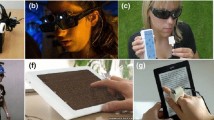Abstract.
This paper provides an overview of a project aimed at using knowledge-based technology to improve accessibility of the Web for visually impaired users. The focus is on the multi-dimensional components of Web pages (tables and frames); our cognitive studies demonstrate that spatial information is essential in comprehending tabular data, and this aspect has been largely overlooked in the existing literature. Our approach addresses these issues by using explicit representations of the navigational semantics of the documents and using a domain-specific language to query the semantic representation and derive navigation strategies. Navigational knowledge is explicitly generated and associated to the tabular and multi-dimensional HTML structures of documents. This semantic representation provides to the blind user an abstract representation of the layout of the document; the user is then allowed to issue commands from the domain-specific language to access and traverse the document according to its abstract layout.
Similar content being viewed by others
Author information
Authors and Affiliations
Additional information
Published online: 6 November 2002
Rights and permissions
About this article
Cite this article
Pontelli, E., Gillan, D., Gupta, G. et al. Intelligent non-visual navigation of complex HTML structures . UAIS 2, 56–69 (2002). https://doi.org/10.1007/s10209-002-0036-4
Issue Date:
DOI: https://doi.org/10.1007/s10209-002-0036-4




